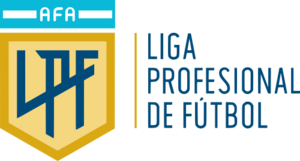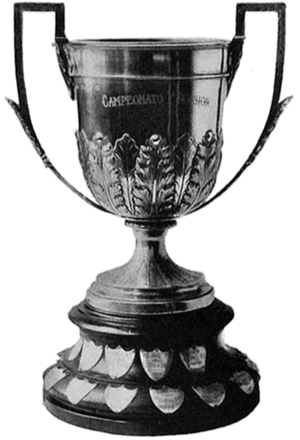Argentine Primera División facts for kids
 |
|
| Organising body | AFA |
|---|---|
| Founded | 12 April 1891 |
| First season | 1891 |
| Country | Argentina |
| Confederation | CONMEBOL |
| Number of teams | 30 |
| Level on pyramid | 1 |
| Relegation to | Primera Nacional |
| Domestic cup(s) | Copa Argentina Supercopa Argentina Trofeo de Campeones Supercopa Internacional |
| International cup(s) | Copa Libertadores Copa Sudamericana |
| Current champions | Platense (2025 Apertura) (1st title) |
| Most championships | River Plate (38 titles) |
| Most appearances | Hugo Gatti (765) |
| Top goalscorer | Arsenio Erico (295) |
| TV partners | ESPN Premium TNT Sports (Argentina) |
The Primera División is Argentina's top professional association football league. It's also known as Liga Profesional de Fútbol. This exciting league is organized by the Argentine Football Association (AFA).
Teams in the Primera División can move up or down between leagues. This system is called promotion and relegation. Teams that finish at the bottom of the Primera División are moved down to the Primera Nacional (Second Division). New teams from the Primera Nacional then get to join the top league.
Argentina was one of the first countries outside the United Kingdom to start a football league. The first championship happened way back in 1891. In the beginning, only teams from certain areas like Buenos Aires and Rosario were part of the national association. Later, teams from other cities joined in.
In 1931, the Primera División became a professional league. This meant players started getting paid. Before that, it was an amateur league, where players played for fun, not money.
Contents
How the League Works
Teams and Matches
The 2025 season has 30 teams competing. These include teams from the previous season and new teams that moved up from the 2023 Primera Nacional.
Teams play each other in a "round-robin" system. This means every team plays against every other team. The team with the most points at the end of the season wins the championship!
Moving Up and Down
Relegation, or moving down to a lower league, is based on an "averaging" system. This means the league looks at how well teams have done over the past three years. The two teams with the lowest average scores are moved down.
At the same time, the winner and runner-up from the Primera Nacional championship get to move up to the Primera División.
National Cups
The team that wins the Primera División championship gets to play in the Trofeo de Campeones de la Liga Profesional. This is a special match against the winner of the Copa de la Liga Profesional.
The Copa de la Liga Profesional is another important tournament. The 2023 edition was held in the second half of that year. Teams were split into two groups and played each other once.
International Competitions
Argentine clubs can also play in big international tournaments. For example, five clubs from Argentina can play in the Copa Libertadores. The Primera División champion automatically gets a spot. The next four best teams in the league also qualify.
For the Copa Sudamericana, six teams from the Primera División can play. These are the clubs that finish from 6th to 11th place in the league table.
History of Argentine Football
Early Amateur Years (1891–1931)
The first football league outside of the British Isles was set up in Argentina in 1891. It was called the Association Argentine Football League. The very first amateur Primera División matches were played on April 12, 1891.
Professional Era (1931–1966)
After 1931, the league became professional. For many years, a single tournament was played each year. The team with the most points became the champion. This system lasted until 1966.
During this time, five famous clubs, known as the "Big Five," won almost all the championships. These teams were River Plate, Boca Juniors, Independiente, Racing, and San Lorenzo.
The system for moving teams down (relegation) based on their average performance over several years was first used in 1957.
Metropolitano and Nacional Tournaments (1967–1985)
In 1967, the league changed. Instead of one tournament, there were two championships each year: the Metropolitano and the Nacional. The Metropolitano was for clubs already in the top league. The Nacional allowed teams from regional tournaments to join.
This change was a big deal for Argentine football. It meant smaller clubs, like Estudiantes de La Plata, could also win championships. Before this, only the "Big Five" usually won.
Over the years, the formats for the Metropolitano and Nacional changed several times. Sometimes they were group tournaments with playoffs, and sometimes they were single or double round-robin tournaments.
The average system for relegation came back in 1983. This happened after a big team, San Lorenzo, was moved down in 1981. Some people thought the averaging system was brought back to help prevent other big teams from being relegated.
European-Style Seasons (1985–1991)
In 1985, Argentina changed its football season to be more like Europe. Instead of starting and ending with the calendar year, the season began in one year and ended in the next. Also, only one tournament was played each year, just like in many European leagues. The team at the top of the table at the end of the season won.
Apertura and Clausura (1991–2012)
A few years later, the single championship was split into two shorter tournaments. These were called "Apertura" (Opening) and "Clausura" (Closing). Each tournament had its own champion. So, two champions were crowned every season.
In 1995–96, a new rule was added: teams got three points for a win, one for a draw, and none for a loss. This is still common in football today.
Inicial and Final (2012–2014)
For the 2012–13 season, the Apertura and Clausura tournaments were renamed "Torneo Inicial" and "Torneo Final." They had a similar format, but only one overall champion was named each season.
Superfinal (2013–2014)
After the Inicial and Final tournaments, the winners played a special match called the Copa Campeonato, also known as the Superfinal. The winner of this match was sometimes considered the overall Primera División champion. For example, Vélez Sarsfield won their 10th championship in 2013 by winning the Superfinal.
However, after 2014, the Superfinal was no longer counted as a Primera División title. It became an official cup instead.
One Tournament Again and Superliga (2014–2020)
From August 2014, the league went back to having one tournament. In 2015, the format changed to include 30 teams.
Later, the AFA announced plans for the next few seasons. In 2017–18, the league became the "Superliga Argentina." This new organization managed the league independently, while the AFA focused on the national teams.
2020–Present
In February 2020, the AFA decided to take back control of organizing the Primera División championships. The Superliga was replaced by a new group called "Liga Profesional de Fútbol" (LPF), which is directly connected to the AFA. The LPF was officially launched in May 2020.
League Levels
| Year | Level | Relegation to |
|---|---|---|
| 1891–1898 |
|
(None) |
| 1899–1910 |
|
Segunda División |
| 1911–1926 |
|
División Intermedia |
| 1927–1932 |
|
Primera División B |
| 1933–1948 |
|
Segunda División |
| 1949–1966 |
|
Primera División B |
| 1967–1986 |
|
Primera División B
Torneo Regional |
| 1986–present |
|
Primera B Nacional |
Top Teams and Champions
Since the first championship in 1891, 29 different clubs have won the Primera División title. Some clubs no longer exist or are not part of the AFA anymore.
| Rank | Club | Titles | Winning seasons |
|---|---|---|---|
| 1 | River Plate |
|
1920 AAmF, 1932 LAF, 1936 (Copa Campeonato), 1936 (Copa de Oro), 1937, 1941, 1942, 1945, 1947, 1952, 1953, 1955, 1956, 1957, 1975 Metropolitano, 1975 Nacional, 1977 Metropolitano, 1979 Metropolitano, 1979 Nacional, 1980 Metropolitano, 1981 Nacional, 1985–86, 1989–90, 1991 Apertura, 1993 Apertura, 1994 Apertura, 1996 Apertura, 1997 Apertura, 1997 Clausura, 1999 Apertura, 2000 Clausura, 2002 Clausura, 2003 Clausura, 2004 Clausura, 2008 Clausura, 2014 Final, 2021, 2023 |
| 2 | Boca Juniors |
|
1919, 1920, 1923, 1924, 1926, 1930, 1931 LAF, 1934 LAF, 1935, 1940, 1943, 1944, 1954, 1962, 1964, 1965, 1969 Nacional, 1970 Nacional, 1976 Metropolitano, 1976 Nacional, 1981 Metropolitano, 1992 Apertura, 1998 Apertura, 1999 Clausura, 2000 Apertura, 2003 Apertura, 2005 Apertura, 2006 Clausura, 2008 Apertura, 2011 Apertura, 2015, 2016–17, 2017–18, 2019–20, 2022 |
| 3 | Racing |
|
1913, 1914, 1915, 1916, 1917, 1918, 1919 AAmF, 1921 AAmF, 1925 AAmF, 1949, 1950, 1951, 1958, 1961, 1966, 2001 Apertura, 2014, 2018–19 |
| 4 | Independiente |
|
1922 AAmF, 1926 AAmF, 1938, 1939, 1948, 1960, 1963, 1967 Nacional, 1970 Metropolitano, 1971 Metropolitano, 1977 Nacional, 1978 Nacional, 1983 Metropolitano, 1988–1989, 1994 Clausura, 2002 Apertura |
| 5 | San Lorenzo |
|
1923 AAmF, 1924 AAmF, 1927, 1933 LAF, 1936 (Copa de Honor), 1946, 1959, 1968 Metropolitano, 1972 Metropolitano, 1972 Nacional, 1974 Nacional, 1995 Clausura, 2001 Clausura, 2007 Clausura, 2013 Inicial |
|
|
Vélez Sarsfield |
|
1968 Nacional, 1993 Clausura, 1995 Apertura, 1996 Clausura, 1998 Clausura, 2005 Clausura, 2009 Clausura, 2011 Clausura, 2012 Inicial, 2012–13 Superfinal, 2024 |
|
|
Alumni |
|
1900, 1901, 1902, 1903, 1905, 1906, 1907, 1909, 1910, 1911 |
|
|
Estudiantes (LP) |
|
1913 FAF, 1967 Metropolitano, 1982 Metropolitano, 1983 Nacional, 2006 Apertura, 2010 Apertura |
| Newell's Old Boys |
|
1974 Metropolitano, 1987–88, 1990–91, 1992 Clausura, 2004 Apertura, 2013 Final | |
|
|
Huracán |
|
1921, 1922, 1925, 1928, 1973 Metropolitano |
| Lomas Athletic | 5 | 1893, 1894, 1895, 1897, 1898 | |
|
|
Rosario Central |
|
1971 Nacional, 1973 Nacional, 1980 Nacional, 1986–87 |
|
|
Argentinos Juniors | 3 | 1984 Metropolitano, 1985 Nacional, 2010 Clausura |
| Belgrano Athletic | 3 | 1899, 1904, 1908 | |
|
|
Estudiantil Porteño |
|
1931, 1934 |
| Ferro Carril Oeste |
|
1982 Nacional, 1984 Nacional | |
| Lanús |
|
2007 Apertura, 2016 | |
| Porteño |
|
1912 FAF, 1914 FAF | |
| Quilmes |
|
1912, 1978 Metropolitano | |
|
|
Arsenal | 1 | 2012 Clausura |
| Banfield |
|
2009 Apertura | |
| Chacarita Juniors |
|
1969 Metropolitano | |
| Dock Sud |
|
1933 | |
| Gimnasia y Esgrima (LP) |
|
1929 | |
| Lomas Academy |
|
1896 | |
| Old Caledonians | 1 | 1891 | |
| Platense |
|
2025 Apertura | |
| Sportivo Barracas |
|
1932 | |
| St. Andrew's |
|
1891 |
Top Goal Scorers
The player with the most goals in the Primera División Argentina is Arsenio Erico. He scored an amazing 295 goals! Most of the top goal scorers played before the 1970s. One famous player who played more recently and is on the top list is Martín Palermo. He played for Estudiantes (LP) and Boca Juniors.
Watching the Games
In Argentina, you can watch the matches on TV channels like ESPN and TNT Sports. These companies signed a big contract to broadcast the games.
Before this, football matches were shown for free in Argentina from 2009 to 2016. This was part of a program called "Fútbol para Todos" (Football for Everyone).
The league is popular all over the world! Matches are broadcast in more than 80 countries. In Latin America, you can watch games live on ESPN and TyC Sports International. In the United States, matches are streamed on Paramount+. BeIN Sports broadcasts the games in France and other regions.
See also
 In Spanish: Primera División de Argentina para niños
In Spanish: Primera División de Argentina para niños


